| |
|
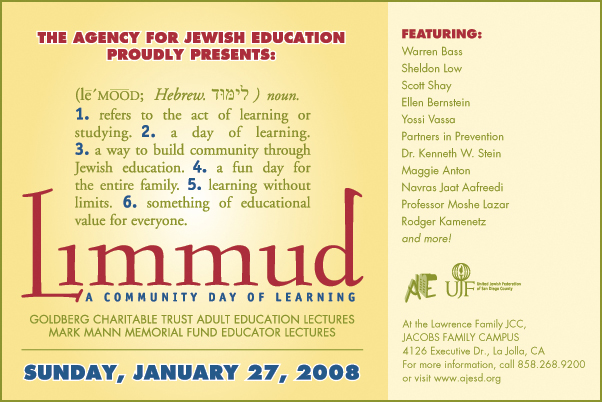

Scholars-in-residence
program
Presentations are free; kosher meals moderately priced
● Rabbi
Yakov Horowitz, founder, Project Y.E.S. (Youth Enrichment Services)
for
Agudath Israel, Jan. 4-5
● Rabbi Ari
Kahn, director, Foreign Student Programs,
Bar Ilan University, Israel, Feb.
22-23
Call us for details at (619)
287-9890, Reserve Shabbaton meals before January 2
|

A HERALD IN ZION
Elementary students demonstrate their new-found knowledge of the Torah
By Dorothea Shefer-Vanson
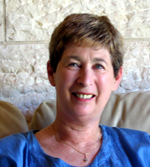 MEVASSERET ZION, Israel—When I contemplate my time at the Jewish primary school I attended in north-west London some fifty years ago there are few incidents of note that remain in my memory. Dull lessons, stultifying routine and hackneyed custom are all that swim into my ken. I do not recollect a single outing to any of the myriad sites of interest or cultural enrichment in which London abounds. I hope that things have improved by today. MEVASSERET ZION, Israel—When I contemplate my time at the Jewish primary school I attended in north-west London some fifty years ago there are few incidents of note that remain in my memory. Dull lessons, stultifying routine and hackneyed custom are all that swim into my ken. I do not recollect a single outing to any of the myriad sites of interest or cultural enrichment in which London abounds. I hope that things have improved by today.
I very much fear that in Israel this is also largely the case. In my own small way I have attempted to remedy the situation as far as my own children and grandchildren are concerned, but this is of course on a very minor level.
Last week, however, I was made aware of a welcome interruption to my smaller grand-daughter’s mundane school routine when I was invited to attend the ceremony marking her and her class-mates’ graduation to the elevated status of being able to read the Bible. They are now in the second form and are considered sufficiently proficient in reading and writing. The school does not belong to the religious education stream so that while the pupils are taught about their cultural, historical and spiritual heritage, they are not subjected to sermonizing and no belief system is inculcated.
The event was held in a local synagogue. It began in the synagogue itself, with the children sitting in the centre and the parents and guests sitting at the back and along the sides. The rabbi, a bearded young man in modern clothing who spoke in a relaxed, everyday manner, quizzed the children on their knowledge of some basic religious concepts. These involved such terms as kiddush, the Temple, the centrality of Jerusalem, the Torah, and the patriarchs (but not the matriarchs). He was somewhat taken aback when a little boy answered ‘Abraham’ when asked who had destroyed the first Temple. At the end of this part of the evening the rabbi took the children to the Ark of the Law and showed them the scrolls inside, even opening one up for their inspection. I was later informed that one little boy, who had insisted on coming despite not being well, vomited on the carpet and had to be taken home. Fortunately, the rabbi had left by then.
Then everyone proceeded to the hall downstairs, where the parents sat on chairs in a circle and the children performed dances and sang songs that were connected with the subject. Most of the songs were modern Israeli songs with only a very vague association with anything biblical, and the dances even less so. But it was an opportunity for the teacher and her wards to show their prowess in both those fields.
The children were very sweet and well-behaved. The teacher and her helpers were proud of their performance, and of course the parents and relatives also enjoyed the event, in the preparation of which considerable effort had evidently been invested.
The festivity ended with each child being called by name to receive the treasured book, after which they all read out its first sentence in unison. It was a very touching moment and reminded those present that nowhere else in the world today is it possible to find six- and seven-year-olds reading and understanding a text that is over two thousand years old.
Since no event in Israel is complete without food, the evening ended with pupils, teachers, parents and guests all falling eagerly on the tables laden with sandwiches, cakes and other goodies that had been prepared by eager volunteers.
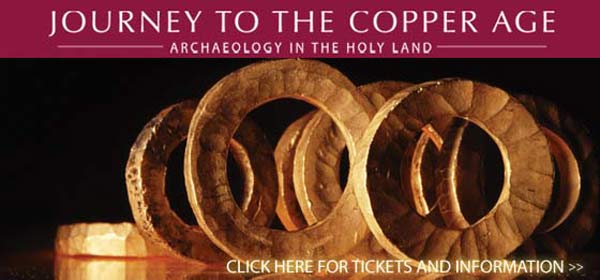

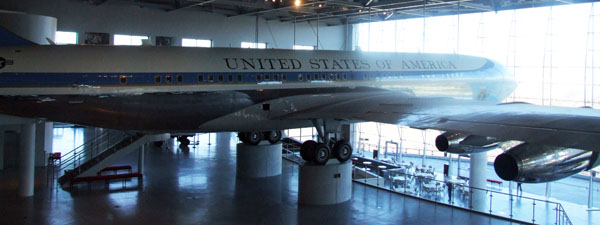
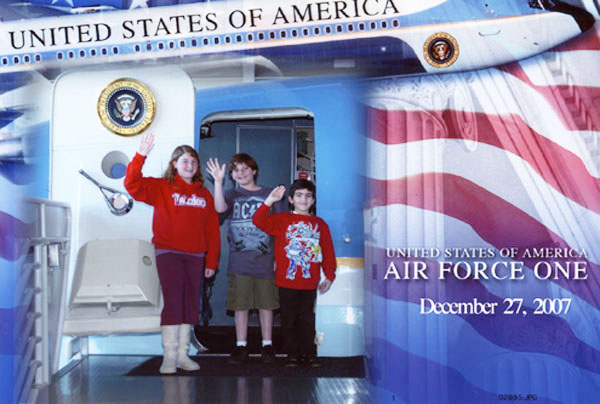
THE JEWISH CITIZEN
Nostalgia: key ingredient at Reagan library
By Donald H. Harrison
 SIMI VALLEY, California—To my surprise, the Air Force One on permanent display at the Ronald Reagan Library and Museum is a Boeing 707, just like the one I once flew on when Richard Nixon was the president. I had thought mistakenly that by the time Reagan entered office, Air Force One had been upgraded to a Boeing 747. However, that didn't occur until 1990, two years into the presidency of George H. W. Bush. A fact sheet revealed that it wasn't the same airplane on which I had flown, as this one entered service in 1973 during Nixon's presidency. I had the privilege of serving as a pool reporter on SIMI VALLEY, California—To my surprise, the Air Force One on permanent display at the Ronald Reagan Library and Museum is a Boeing 707, just like the one I once flew on when Richard Nixon was the president. I had thought mistakenly that by the time Reagan entered office, Air Force One had been upgraded to a Boeing 747. However, that didn't occur until 1990, two years into the presidency of George H. W. Bush. A fact sheet revealed that it wasn't the same airplane on which I had flown, as this one entered service in 1973 during Nixon's presidency. I had the privilege of serving as a pool reporter on
Donald H. Harrison
the sister Air Force One during the 1972 campaign while I was working as a politics writer for The San Diego Union. I was chosen for the assignment because Nixon was flying to a campaign appearance in San Diego, and being a reporter from that city, it was assumed I might have something of local interest to add to the pool report. As I recall, I was the only representative of San Diego media on that flight.
Typically presidents have two identical aircraft in the presidential fleet at any time, and whichever one the sitting president is riding on is designated as Air Force One. It is accorded priority landing and takeoff rights at all American airports. Its chief passenger, after all, is the President of the United States, whose business, one assumes, is more important than the business of any other executive who might be inside a plane waiting on a runway.
Although I had seen the press quarters of Air Force One, which were in the back of the aircraft, I never had seen the private offices of the President and First Lady, the communications consoles, nor the conference room, where Presidents frequently met with high-powered guests. So walking through it was an enjoyable experience, helping me to visualize what it had been like on the other side of the bulkhead on that day of my Air Force One flight. For my grandson Shor Masori, and great niece and great nephew Ashlee and Tyler Ford, the experience seemed equally interesting, especially since a professional photographer had set up to take photos of visitors entering the plane or, in the children's case, practicing a presidential wave.
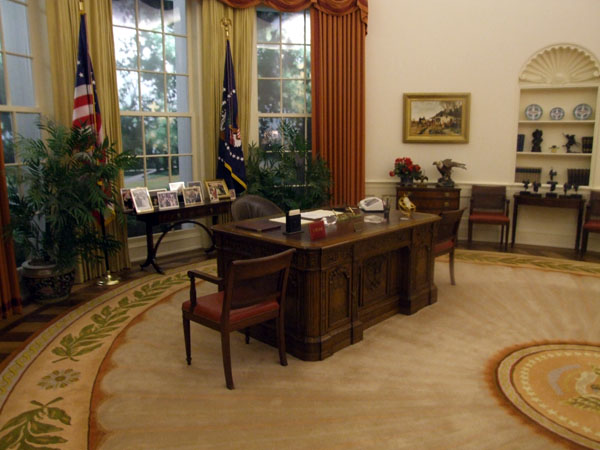
Air Force One is among what I consider the three most impressive sights of a visit to the Ronald Reagan Presidential Library and Museum. A second is the re-creation of the Oval Office, as Reagan had it furnished, including the desk that John F. Kennedy previously had used and which his son, John John, used to crawl under as a toddler. The desk at the Reagan Library was a reproduction; the original still is at the White House and is used by the incumbent president, George W. Bush.
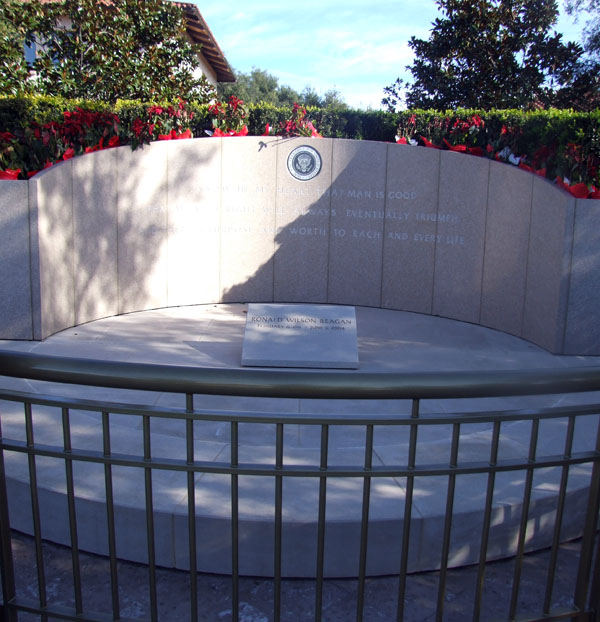
The third major attraction is President Reagan's burial place alongside the long Spanish style library and museum building. Standing in front of it, I could not help but remember watching the week of honors rendered to Reagan following his death in June 2004.
A current exhibit, which held the attention of the women in our tour group, was a collection of dresses and gowns worn by Nancy Reagan during her lifetime. A perfect size 2, she had the kind of figure designers like to create gowns for. However, my favorite apparel was a beat up assemblage in which she surprised the Press Corps and her husband at a Gridiron Dinner. She left the dinner temporarily, changed her clothes, and appeared on stage in hand-me-downs. Then she sang the song "Second-Hand Rose," which Barbra Streisand made famous in Funny Girl, the movie about Fannie Bryce. The occasion indicated to the Press Corps that Nancy Reagan actually did have a sense of humor and could laugh at herself.
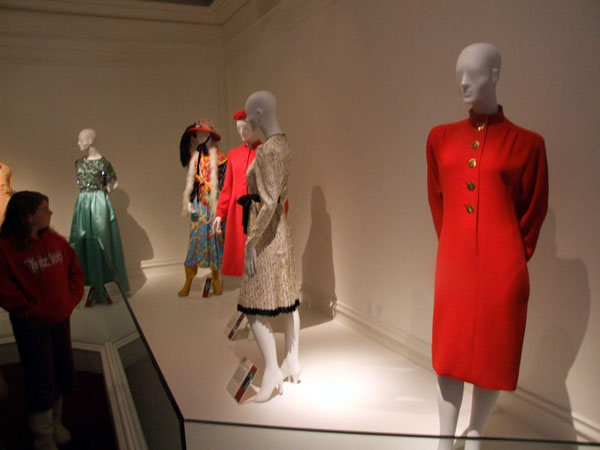
This being the holiday season, there was amid the Christmas decorations a collection on display of menorahs that had been presented to Ronald Reagan during his presidency. One was from Israel's then-President Yitzhak Navon; another from the head of Yeshiva University; a number of others from the Lubavitcher movement.
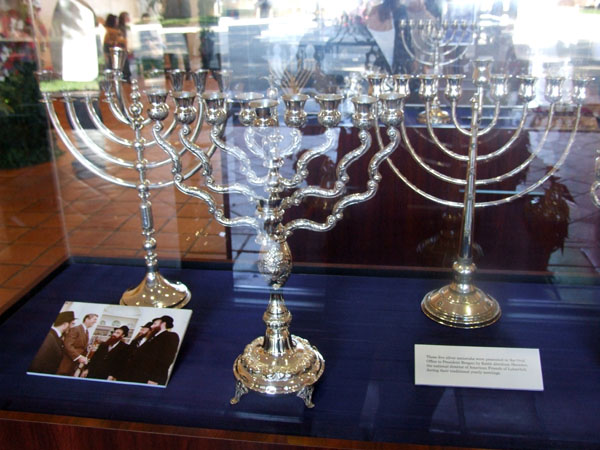
Two others in particular had stories attached to them. One was presented by the Jewish Community Center of Greater Washington to Reagan, who responded with a speech urging the Soviet Union to permit Jews to freely emigrate. About the menorah, he said:
"We are reminded of Jewish unity and diversity by the eight separate branches of the menorah coming together as one. As the menorah’s light grows stronger with one candle being lit each day, you can feel the flame of freedom burning in your hearts and that flame should inspire people everywhere..”
Another menorah was presented to him by Eleanor Ray, a school girl to whom he granted an interview. Her letter accompanying the menorah said:
"Dear President Reagan I want to thank you from the deepness of my heart for the inspiring interview you granted me . I 'll remember our meeting for the rest of my life and this will probably be one of the most memorable events from my childhood. I want you to get get this menorah because this is a symbol of freedom in my Jewish heritage and as you said freedom is the most important thing we have as Americans. The Hannukah menorah is a symbol of the Jewish people’s love of liberty. By the light of the menorah my parents told me the tale of Judah Maccabee, the hero who died for freedom…"
There are exhibits in the museum on Reagan's life before, during and after his presidency. Still photographs of people who visited him at the White House included Israel's Ambassador to the U.S. and later Prime Minister Yitzhak Rabin, and the virtuoso pianist Vladimir Horowitz. Our guide recalled that on one occasion, Nancy Reagan sat down on a chair that was too close to the edge of the stage and toppled. Horowitz was the one who quickly helped her up.
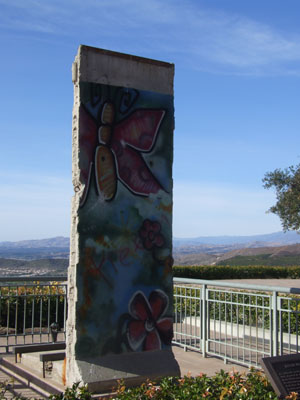 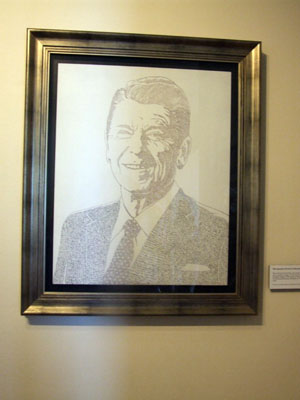
Among the more touching exhibits is a chunk of the Berlin Wall, which Reagan in a famous 1987 speech urged Soviet Communist Party Secretary Mikhail Gorbachev to tear down. The speech was set down in micro-writing and used to draw a portrait of Reagan that was presented by Joseph Leibovic , founder of Los Angeles Pop Art.
It is a style that I have seen artists in Safed often use to depict passages from the Tanakh. Perhaps as much as anything said by our knowledgeable docent, Angie Ruf (a friend and former neighbor of my niece Caren's family), that conveyed the reverence so many people have for our nation's 40th president.
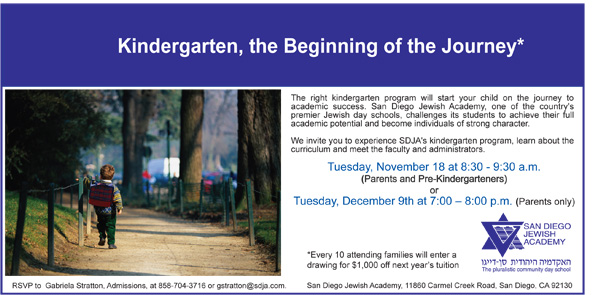


SAN DIEGO JEWISH WORLD THE WEEK IN REVIEW
THURSDAY, DECEMBER 27
Donald H. Harrison in Anaheim, California: Disneyland on one foot
Dorothea Shefer-Vanson in Mevasseret Zion, Israel: A young man scouts way to girl's heart
WEDNESDAY, DECEMBER 26
Garry Fabian in Melbourne, Australia: Jews support increased aid to Palestinians ... A battle over the fairness of the beth din
Donald H. Harrison in Ventura, California: A Jewish lad experiences Christmas up close
TUESDAY, DECEMBER 25
Donald H. Harrison in Los Angeles: Pulling up the sticky vestiges of the past
Bruce Kesler in Encinitas, California: Those Jews and their Christmas songs
MONDAY, DECEMBER 24
Donald H. Harrison in Los Angeles: Religious study in hall of African mammals
Sheila Orysiek in San Diego: A Jewish child grows up on Christmas Eve
Ira Sharkansky in Jerusalem: An Israeli view of the 'settlements'
SUNDAY, DECEMBER 23
Shoshana Bryen in Washington, D.C.: On Putin, Time's 'Person of the Year'
Donald H. Harrison in San Diego: Jury service left editor with mixed feelings
Rabbi Baruch Lederman in San Diego: A child's possession held for safekeeping
Rabbi Leonard Rosenthal in San Diego: Why is Judah represented by the lion?
Ira Sharkansky in Jerusalem: Want better health care? Make aliyah!
< BACK TO TOP
|
|

